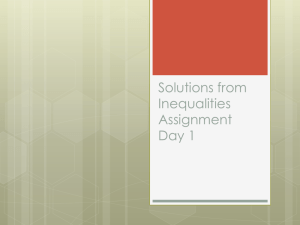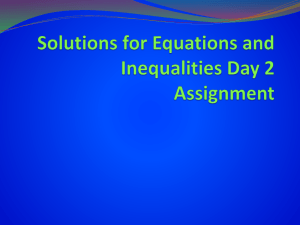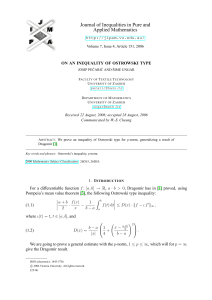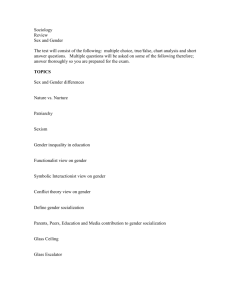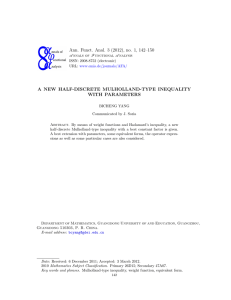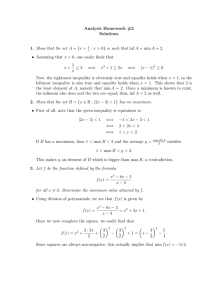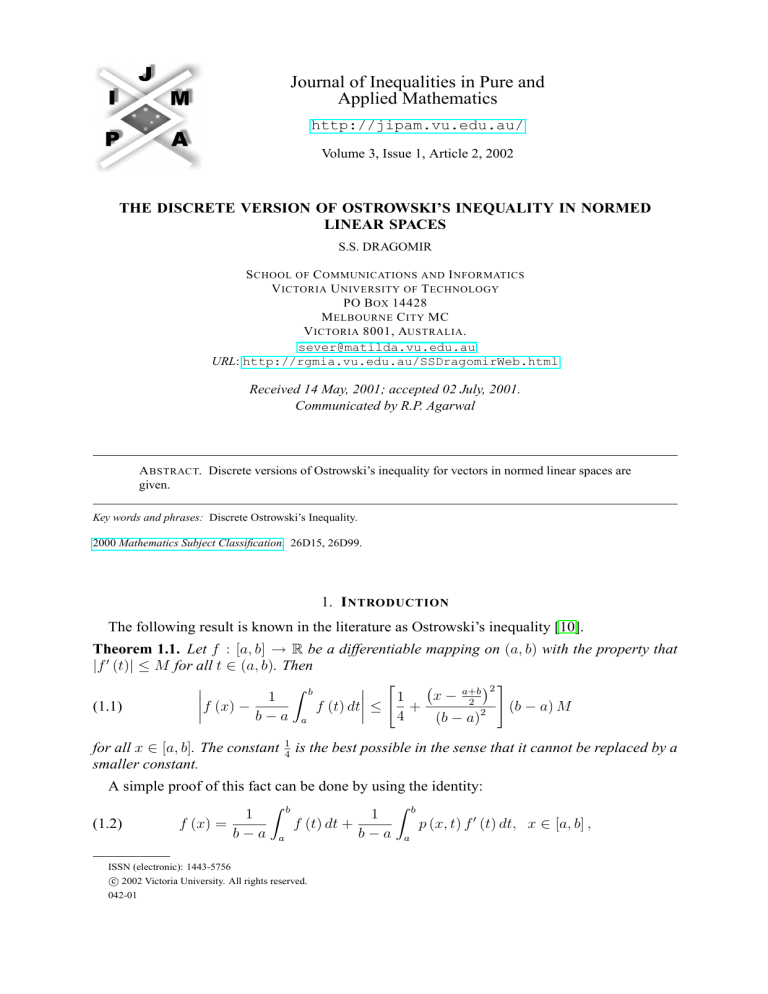
Journal of Inequalities in Pure and
Applied Mathematics
http://jipam.vu.edu.au/
Volume 3, Issue 1, Article 2, 2002
THE DISCRETE VERSION OF OSTROWSKI’S INEQUALITY IN NORMED
LINEAR SPACES
S.S. DRAGOMIR
S CHOOL OF C OMMUNICATIONS AND I NFORMATICS
V ICTORIA U NIVERSITY OF T ECHNOLOGY
PO B OX 14428
M ELBOURNE C ITY MC
V ICTORIA 8001, AUSTRALIA .
sever@matilda.vu.edu.au
URL: http://rgmia.vu.edu.au/SSDragomirWeb.html
Received 14 May, 2001; accepted 02 July, 2001.
Communicated by R.P. Agarwal
A BSTRACT. Discrete versions of Ostrowski’s inequality for vectors in normed linear spaces are
given.
Key words and phrases: Discrete Ostrowski’s Inequality.
2000 Mathematics Subject Classification. 26D15, 26D99.
1. I NTRODUCTION
The following result is known in the literature as Ostrowski’s inequality [10].
Theorem 1.1. Let f : [a, b] → R be a differentiable mapping on (a, b) with the property that
|f 0 (t)| ≤ M for all t ∈ (a, b). Then
"
2 #
Z b
x − a+b
1
1
2
(1.1)
f (x) −
f (t) dt ≤
+
(b − a) M
b−a a
4
(b − a)2
for all x ∈ [a, b]. The constant
smaller constant.
1
4
is the best possible in the sense that it cannot be replaced by a
A simple proof of this fact can be done by using the identity:
Z b
Z b
1
1
(1.2)
f (x) =
f (t) dt +
p (x, t) f 0 (t) dt, x ∈ [a, b] ,
b−a a
b−a a
ISSN (electronic): 1443-5756
c 2002 Victoria University. All rights reserved.
042-01
2
S.S. D RAGOMIR
where
p (x, t) :=
t − a if a ≤ t ≤ x
t − b if x < t ≤ b
which also holds for absolutely continuous functions f : [a, b] → R.
The following Ostrowski type result for absolutely continuous functions holds (see [6] – [8]).
Theorem 1.2. Let f : [a, b] → R be absolutely continuous on [a, b]. Then, for all x ∈ [a, b], we
have:
Z b
1
(1.3) f (x) −
f (t) dt
b−a a
a+b 2 x−
1
+ b−a2
(b − a) kf 0 k∞
if f 0 ∈ L∞ [a, b] ;
4
h
i1
1
1
x−a p+1
b−x p+1 p
0
≤
p kf 0 k
+
(b
−
a)
1
q if f ∈ Lq [a, b] ,
b−a
b−a
p
(p+1)
1
+ 1q = 1, p > 1;
p
h
i
a+b
1 + x− 2
kf 0 k ;
2
1
b−a
where k·kr (r ∈ [1, ∞]) are the usual Lebesgue norms on Lr [a, b], i.e.,
kgk∞ := ess sup |g (t)|
t∈[a,b]
and
Z
kgkr :=
b
r1
|g (t)|r dt , r ∈ [1, ∞).
a
The constants 14 ,
1
1
(p+1) p
and
1
2
respectively are sharp in the sense presented in Theorem 1.1.
The above inequalities can also be obtained from the Fink result in [9] on choosing n = 1
and performing some appropriate computations.
If one drops the condition of absolute continuity and assumes that f is Hölder continuous,
then one may state the result (see [5]):
Theorem 1.3. Let f : [a, b] → R be of r − H−Hölder type, i.e.,
(1.4)
|f (x) − f (y)| ≤ H |x − y|r , for all x, y ∈ [a, b] ,
where r ∈ (0, 1] and H > 0 are fixed. Then, for all x ∈ [a, b] , we have the inequality:
"
r+1 r+1 #
Z b
1
H
b−x
x−a
(1.5)
f (x) −
f (t) dt ≤
+
(b − a)r .
b−a a
r+1
b−a
b−a
1
The constant r+1
is also sharp in the above sense.
Note that if r = 1, i.e., f is Lipschitz continuous, then we get the following version of
Ostrowski’s inequality for Lipschitzian functions (with L instead of H) (see [4])
!2
Z b
a+b
x− 2
1
1
(b − a) L.
(1.6)
f (x) −
f (t) dt ≤ +
b−a a
4
b−a
Here the constant 14 is also best.
Moreover, if one drops the condition of the continuity of the function, and assumes that it is
of bounded variation, then the following result may be stated (see [2]).
J. Inequal. Pure and Appl. Math., 3(1) Art. 2, 2002
http://jipam.vu.edu.au/
D ISCRETE V ERSION OF O STROWSKI ’ S I NEQUALITY
3
Theorem 1.4. Assume that f : [a, b] → R is of bounded variation and denote by
b
W
(f ) its total
a
variation. Then
(1.7)
1
f (x) −
b−a
b
Z
a
"
x − a+b
1
2
f (t) dt ≤
+
2
b−a
#
b
_
(f )
a
for all x ∈ [a, b]. The constant 12 is the best possible.
If we assume more about f , i.e., f is monotonically increasing, then the inequality (1.7) may
be improved in the following manner [3] (see also [1]).
Theorem 1.5. Let f : [a, b] → R be monotonic nondecreasing. Then for all x ∈ [a, b], we have
the inequality:
Z b
1
(1.8)
f (t) dt
f (x) −
b−a a
Z b
1
≤
[2x − (a + b)] f (x) +
sgn (t − x) f (t) dt
b−a
a
1
{(x − a) [f (x) − f (a)] + (b − x) [f (b) − f (x)]}
≤
b
−
a
#
"
x − a+b
1
2
+
[f (b) − f (a)] .
≤
2
b−a
All the inequalities in (1.8) are sharp and the constant 21 is the best possible.
For other recent results including Ostrowski type inequalities for n-time differentiable functions, visit the RGMIA website at http://rgmia.vu.edu.au/database.html.
In this paper we point out some discrete Ostrowski type inequalities for vectors in normed
linear spaces.
2. S OME I DENTITIES
The following lemma holds.
Lemma 2.1. Let xi (i = 1, . . . , n) be vectors in X. Then we have the representation
n
(2.1)
n
1X
1X
xi =
xj +
p (i, j) ∆xj , i ∈ {1, . . . , n} ,
n j=1
n j=1
where
(2.2)
p (1, j) = j − n if 1 ≤ j ≤ n − 1;
(2.3)
p (n, j) = j if 1 ≤ j ≤ n − 1;
and
(2.4)
p (i, j) =
j
if 1 ≤ j ≤ i − 1,
j − n if i ≤ j ≤ n − 1,
where 2 ≤ i ≤ n − 1 and 1 ≤ j ≤ n − 1.
J. Inequal. Pure and Appl. Math., 3(1) Art. 2, 2002
http://jipam.vu.edu.au/
4
S.S. D RAGOMIR
Proof. For i = 1, we have to prove that
n
n
1X
1X
x1 =
xj +
(j − n) ∆xj .
n j=1
n j=1
(2.5)
Using the summation by parts formula, we have
n
X
(j − n) ∆xj = (j −
n
n) xj j=1
n−1
X
−
j=1
∆ (j − n) xj+1
j=1
n−1
X
= (n − 1) x1 −
xj+1
j=1
= nx1 −
n
X
xj
j=1
and the formula (2.5) is proved.
For i = n, we can prove similarly that
n
xn =
(2.6)
n−1
1X
1X
xj +
j∆xj .
n j=1
n j=1
Let 2 ≤ i ≤ n − 1. We have
(2.7)
n−1
X
p (i, j) ∆xj =
j=1
i−1
X
p (i, j) ∆xj +
j=1
=
i−1
X
n−1
X
p (i, j) ∆xj
j=i
i∆xj +
n−1
X
j=1
(j − n) ∆xj .
j=i
Using the summation by parts formula, we have
i−1
X
(2.8)
i∆xj =
n
jxj j=i
−
j=1
i−1
X
∆ (i) xj+1
j=1
= ixi − x1 −
i−1
X
xj+1
j=1
= (i − 1) xi −
i−1
X
xj
j=1
and
(2.9)
n−1
X
(j − n) ∆xj = (j −
n
n) xj j=i
−
j=i
n−1
X
∆ (j − n) xj+1
j=i
= (n − i) xi −
n−1
X
xj+1
j=i
= (n − i + 1) xi −
n
X
xj .
j=i
J. Inequal. Pure and Appl. Math., 3(1) Art. 2, 2002
http://jipam.vu.edu.au/
D ISCRETE V ERSION OF O STROWSKI ’ S I NEQUALITY
5
Using (2.7) – (2.9), we deduce
n−1
X
p (i, j) ∆xj = (i − 1) xi −
i−1
X
j=1
xj + (n − i + 1) xi −
j=1
= nxi −
n
X
n
X
xj
j=i
xj
j=1
and the identity (2.1) is proved.
The following corollaries hold.
Corollary 2.2. We have the identity
n
n
1X
1 X
n
x1 + xn
=
xj +
j−
∆xj .
2
n j=1
n j=1
2
(2.10)
Corollary 2.3. Let n = 2m + 1. Then we have
(2.11)
xm+1
2m+1
2m
X
X
1
1
=
xj +
pm (j) ∆xj ,
2m + 1 j=1
2m + 1 j=1
where
pm (j) =
j
if 1 ≤ j ≤ m,
j − 2m − 1 if m + 1 ≤ j ≤ 2m.
3. D ISCRETE O STROWSKI ’ S I NEQUALITY
The following discrete inequality of Ostrowski type holds.
Theorem 3.1. Let (X, k·k) be a normed linear space and xi (i = 1, . . . , n) be vectors in X.
Then we have the inequality
"
#
2
n
1X
1
n+1
n2 − 1
(3.1)
xk ≤
i−
+
max k∆xk k ,
xi −
k=1,...,n−1
n k=1
n
2
4
for all i ∈ {1, . . . , n}. The constant c =
cannot be replaced by a smaller one.
1
4
in the right hand side is best in the sense that it
Proof. We use the representation (2.1) and the generalised triangle inequality to obtain
n
1X
xi −
xk
n k=1
n−1
1 X
=
p (i, k) ∆xk
n k=1
n−1
≤
1X
|p (i, k)| k∆xk k
n k=1
n−1
1X
≤
max k∆xk k ×
|p (i, k)| .
k=1,...,n−1
n k=1
If i = 1, then we have
n−1
X
|p (1, k)| =
k=1
J. Inequal. Pure and Appl. Math., 3(1) Art. 2, 2002
n−1
X
k=1
|k − n| =
n−1
X
k=1
k=
n (n − 1)
2
http://jipam.vu.edu.au/
6
S.S. D RAGOMIR
and as
n+1
1−
2
2
+
n2 − 1
n (n − 1)
=
, for n ≥ 1
4
2
the inequality (3.1) is valid for i = 1.
Let 2 ≤ i ≤ n − 1. Then
n−1
X
i−1
X
|p (i, k)| =
k=1
|p (i, k)| +
k=1
i−1
X
=
k=1
n−1
X
|p (i, k)|
k=i
k+
n−1
X
(n − k)
k=i
!
n−1
i−1
X
X
(i − 1) i
=
+ n (n − 1 − i + 1) −
k−
k
2
k=1
k=1
(i − 1) i
n (n − 1) i (i − 1)
=
+ n (n − i) −
−
2
2
2
1
=
2i2 + n2 − 2ni + n
2
2
n+1
n2 − 1
=
i−
+
2
4
and the inequality (3.1) is also proved for i ∈ {2, . . . , n − 1}.
For i = n, we have p (n, k) = k, k = 1, . . . , n − 1 giving
n−1
X
|p (n, k)| =
k=1
n−1
X
k=1
k=
n (n − 1)
2
and as
n+1
n−
2
2
n2 − 1
n (n − 1)
+
=
4
2
the inequality (3.2) is also valid for i = n.
To prove the sharpness of the constant c = 14 , assume that (3.1) holds with a constant c > 0,
i.e.,
"
#
2
n
1X
1
n+1
(3.2)
xi −
xk ≤
i−
+ c n2 − 1
max k∆xk k
k=1,...,n−1
n k=1
n
2
for any xk (k = 1, . . . , n) in X.
Let xk = x1 + (k − 1) r, k = 1, . . . , n, r ∈ X, r 6= 0, x1 6= 0 and i = 1 in (3.2). Then we
get
"
#
n
1X
1 (n − 1)2
(3.3)
x1 −
(x1 + (k − 1) r) ≤
+ c n2 − 1 krk
n k=1
n
4
and as
n
X
(x1 + (k − 1) r) = nx1 +
k=1
J. Inequal. Pure and Appl. Math., 3(1) Art. 2, 2002
n (n − 1)
r,
2
http://jipam.vu.edu.au/
D ISCRETE V ERSION OF O STROWSKI ’ S I NEQUALITY
7
then from (3.3) we deduce
"
#
n−1
1 (n − 1)2
·r ≤
+ c n2 − 1 krk
2
n
4
from where we get
1
1 n−1
≤
+ c (n + 1)
2
n
4
i.e.,
n + 1 ≤ 4c (n + 1) ,
which implies that c ≥ 14 , and the theorem is proved.
Corollary 3.2. Under the above assumptions and if n = 2m + 1, then we have the inequality
(3.4)
xm+1 −
2m+1
X
1
m (m + 1)
xk ≤
max k∆xk k .
2m + 1 k=1
2m + 1 k=1,...,2m
The proof is obvious by the above Theorem 3.1 for i = m + 1.
The following corollary also holds.
Corollary 3.3. Under the above assumptions, we have:
a) If n = 2k, then
(3.5)
2k
x1 + x2k
1 X
1
−
xj ≤ (k − 1) max k∆xj k .
j=1,...,2k−1
2
2k j=1
2
b) If n = 2k + 1, then
(3.6)
2k+1
x1 + x2k+1
1 X
2k 2 + 2k + 1
−
xj ≤
max k∆xj k .
2
2k + 1 j=1
2 (2k + 1) j=1,...,2k
Proof. The proof is as follows.
a) If n = 2k, then by Corollary 2.2, we have
2k
2k−1
x1 + x2k
1 X
1 X
−
xj ≤
|j − k| k∆xj k
2
2k j=1
2k j=1
1
≤
2k
1
=
2k
max
j=1,...,2k−1
max
j=1,...,2k−1
k∆xj k
2k−1
X
|j − k|
j=1
k∆xj k
k
X
(k − j) +
j=1
2k−1
X
!
(j − k)
j=k+1
1
(k − 1) k
max k∆xj k
k j=1,...,2k−1
2
1
= (k − 1) max k∆xj k ,
j=1,...,2k−1
2
=
and the inequality (3.5) is proved.
J. Inequal. Pure and Appl. Math., 3(1) Art. 2, 2002
http://jipam.vu.edu.au/
8
S.S. D RAGOMIR
b) If n = 2k + 1, then by Corollary 2.2, we have
2k+1
x1 + x2k+1
1 X
−
xj
2
2k + 1 j=1
2k+1
2k + 1
1 X
≤
j−
k∆xj k
2k + 1 j=1
2
2k+1
X
1
1
max k∆xj k
j−k−
2k + 1 j=1,...,2k
2
j=1
" k 2k+1
#
X
X 1
1
1
=
max k∆xj k
k+ −j +
j−k−
2k + 1 j=1,...,2k
2
2
j=1
j=k+1
"
#
k
2k+1
X
X
1
1
1
max k∆xj k k +
(j − k)
=
(k − j) − (k + 1) +
2k + 1 j=1,...,2k
2
2
j=1
j=k+1
2
1
k − k + k 2 + 3k + 2 − 1
=
max k∆xj k
2k + 1 j=1,...,2k
2
2
2k + 2k + 1
= max k∆xj k
j=1,...,2k
2 (2k + 1)
≤
and the inequality (3.6) is proved.
The following result including a version of a discrete Ostrowski inequality for lp −norms of
{∆xi }i=1,n−1 also holds.
Theorem 3.4. Let (X, k·k) be a normed linear space and xi (i = 1, . . . , n) be vectors in X.
Then we have the inequality
" n−1
# β1
n
X
1
1X
1
xi −
xk ≤ [sα (i − 1) + sα (n − i)] α
k∆xk kβ
n k=1
n
k=1
(3.7)
for all α > 1,
1
α
+
1
β
= 1, where sα (·) denotes the sum:
sα (m) :=
m
X
j α.
j=1
When m = 0, the sum is assumed to be zero.
Proof. Using representation (2.2) and the generalised triangle inequality, we have:
n
(3.8)
1X
xi −
xk
n k=1
n−1
1 X
=
p (i, k) ∆xk
n k=1
n−1
1X
≤
|p (i, k)| k∆xk k =: B.
n k=1
J. Inequal. Pure and Appl. Math., 3(1) Art. 2, 2002
http://jipam.vu.edu.au/
D ISCRETE V ERSION OF O STROWSKI ’ S I NEQUALITY
9
Using Hölder’s discrete inequality, we have
n−1
X
1
B≤
n
(3.9)
! α1
α
|p (i, k)|
k=1
n−1
X
! β1
β
k∆xk k
.
k=1
However,
n−1
X
α
|p (i, k)|
=
k=1
i−1
X
α
|p (i, k)| +
k=1
=
i−1
X
n−1
X
|p (i, k)|α
k=i
kα +
k=1
α
n−1
X
(n − k)α
k=i
= 1 + · · · + (i − 1)α + (n − i)α + · · · + 1α
= sα (i − 1) + sα (n − i)
and the inequality (3.7) then follows by (3.8) and (3.9).
The case of α = β = 2 can be useful in practical applications.
Corollary 3.5. With the assumptions of Theorem 3.4, we have
"
# 12 " n−1
# 12
2
n
2
X
X
1
n −1
1
n+1
xi −
xk ≤ √
i−
+
k∆xk k2 .
(3.10)
n k=1
2
12
n
k=1
Proof. For α = 2, we have
s2 (i − 1) =
i−1
X
i (i − 1) (2i − 1)
6
k2 =
k=1
and
s2 (n − i) =
n−i
X
k2 =
k=1
(n − i) (n − i + 1) [2 (n − i) + 1]
.
6
As simple algebra proves that
"
s2 (i − 1) + s2 (n − i) = n
n+1
i−
2
2
#
n2 − 1
+
,
12
then, by (3.7) we deduce the desired inequality (3.10).
Corollary 3.6. Under the above assumptions and if n = 2m + 1, then we have the inequality:
" 2m
# β1
1
2m+1
X
X
α
1
1
2
(3.11)
xm+1 −
xk ≤
[sα (m)] α
k∆xk kβ
2m + 1 k=1
2m + 1
k=1
for α > 1, α1 + β1 = 1.
In particular, for α = β = 2, we have
(3.12)
2m+1
X
1
xm+1 −
xk ≤
2m + 1 k=1
s
" 2m
# 12
m (m + 1) X
k∆xk k2 .
3 (2m + 1) k=1
The following result providing an upper bound in terms of the l1 −norm of (∆xk )k=1,n−1 also
holds.
J. Inequal. Pure and Appl. Math., 3(1) Art. 2, 2002
http://jipam.vu.edu.au/
10
S.S. D RAGOMIR
Theorem 3.7. Let (X, k·k) be a normed linear space and xi (i = 1, . . . , n) be vectors in X.
Then we have the inequality
(3.13)
n−1
n
1X
1 1
n+1 X
xk ≤
k∆xk k
xi −
(n − 1) + i −
n k=1
n 2
2
k=1
for all i ∈ {1, . . . , n}.
Proof. As in Theorem 3.4, we have
n
1X
xk ≤ B,
xi −
n k=1
(3.14)
where
n−1
1X
B :=
|p (i, k)| k∆xk k .
n k=1
It is obvious that
B =
≤
=
=
=
" i−1
#
n−1
X
X
1
k k∆xk k +
(n − k) k∆xk k
n k=1
k=i
"
#
i−1
n−1
X
X
1
(i − 1)
k∆xk k + (n − i)
k∆xk k
n
k=1
k=i
" i−1
#
n−1
X
X
1
max {i − 1, n − i}
k∆xk k +
k∆xk k
n
k=1
k=i
X
n−1
1 1
1
(n − 1) + |n − i − i + 1|
k∆xk k
n 2
2
k=1
X
n−1
1 1
n+1
(n − 1) + i −
k∆xk k
n 2
2
k=1
and the inequality (3.13) is proved.
The following corollary contains the best inequality we can get from (3.13).
Corollary 3.8. Let (X, k·k) be as above and n = 2m + 1. Then we have the inequality
(3.15)
2m+1
2m
X
1
m X
xk ≤
k∆xk k .
xm+1 −
2m + 1 k=1
2m + 1 k=1
4. W EIGHTED O STROWSKI I NEQUALITY
We start with the following theorem.
J. Inequal. Pure and Appl. Math., 3(1) Art. 2, 2002
http://jipam.vu.edu.au/
D ISCRETE V ERSION OF O STROWSKI ’ S I NEQUALITY
11
Theorem 4.1. Let P
(X, k·k) be a normed linear space, xi ∈ X (i = 1, . . . , n) and pi ≥ 0
(i = 1, . . . , n) with ni=1 pi = 1. Then we have the inequality:
(4.1)
xi −
n
X
pj xj
j=1
n
X
≤
pj |j − i| · max k∆xk k
k=1,n−1
j=1
≤ max k∆xk k ×
k=1,n−1
n−1
2
+ i−
n
P
n+1
2
,
! p1
|j − i|p
j=1
h 2
n 4−1 + i −
! 1q
n
P
pqj
if p > 1,
j=1
n+1 2
2
i
1
p
+
1
q
= 1,
max {pj }
j=1,n
for all i ∈ {1, . . . , n}.
Proof. Using the properties of the norm, we have
n
X
(4.2)
pj kxi − xj k ≥
j=1
n
X
pj (xi − xj )
j=1
=
n
X
xi
n
X
pj −
j=1
=
xi −
pj xj
j=1
n
X
pj xj ,
j=1
for all i ∈ {1, . . . , n}.
On the other hand,
(4.3)
n
X
pj kxi − xj k =
j=1
i−1
X
pj kxi − xj k +
j=1
=
≤
i−1
X
pj kxi − xj k
j=i+1
pj
i−1
X
k=j
i−1
X
i−1
X
pj
n
X
(xk+1 − xk ) +
j=1
j=1
n
X
pj
j−1
X
j=i+1
!
k∆xk k
k=j
+
n
X
j=i+1
pj
(xl+1 − xl )
l=i
j−1
X
!
k∆xl k
=: A.
l=i
Now, as
i−1
X
k∆xk k ≤ (i − j) max k∆xk k (where j ≤ i − 1)
k=j,i−1
k=j
and
s−1
X
k∆xl k ≤ (s − i) max k∆xl k (where i ≤ s − 1),
l=i
J. Inequal. Pure and Appl. Math., 3(1) Art. 2, 2002
l=i,n−1
http://jipam.vu.edu.au/
12
S.S. D RAGOMIR
then we deduce that
A ≤
i−1
X
pj (i − j) · max k∆xk k +
k=j,i−1
j=1
≤
max k∆xk k
" i−1
X
k=1,n−1
=
n
X
max k∆xk k ·
j=1
n
X
k=1,n−1
pj (j − i) · max k∆xl k
l=i,n−1
j=i+1
#
n
X
pj (i − j) +
pj (j − i)
j=i+1
pj |i − j|
j=1
and the first inequality in (4.1) is proved.
Now, we observe that
n
X
pj |i − j| ≤ max |i − j|
n
X
j=1,n
j=1
pj
j=1
= max |i − j|
j=1,n
= max {i − 1, n − i}
n−1
n+1
=
+ i−
,
2
2
which proves the first part of the second inequality in (4.1).
By Hölder’s discrete inequality, we also have
! 1q
! p1
n
n
n
X
X
X
pj |i − j| ≤
pqj
|i − j|p
,
j=1
j=1
j=1
where p > q and p1 + 1q = 1, and the second part of the second inequality in (4.1) holds.
Finally, we also have
n
n
X
X
pj |i − j| ≤ max |pj |
|i − j| .
j=1,n
j=1
j=1
Now, let us observe that
n
X
|i − j| =
j=1
=
i
X
|i − j| +
n
X
j=1
j=i+1
i
X
n
X
j=1
(i − j) +
|i − j|
(j − i)
j=i+1
n
i
X
i (i + 1) X
= i −
+
j−
j − i (n − i)
2
j=1
j=1
2
n2 − 1
n+1
=
+ i−
4
2
2
and the last part of the second inequality in (4.1) is proved.
J. Inequal. Pure and Appl. Math., 3(1) Art. 2, 2002
http://jipam.vu.edu.au/
D ISCRETE V ERSION OF O STROWSKI ’ S I NEQUALITY
13
Remark 4.2. In some practical applications the case p = q = 2 in the second part of the second
inequality may be useful. As
n
n
n
X
X
X
2
2
(j − i) =
j − 2i
j + ni2
j=1
j=1
j=1
"
2 #
n2 − 1
n+1
= n
,
+ i−
12
2
then we may state the inequality
(4.4)
xi −
n
X
pj xj ≤
√
j=1
2 # 12
n+1
n2 − 1
n
+ i−
12
2
"
n
X
j=1
! 12
p2j
max k∆xk k
k=1,n−1
for all i ∈ {1, . . . , n}.
The following particular case was proved in a different manner in Theorem 3.1.
Corollary 4.3. If xi (i = 1, . . . , n) are vectors in the normed linear space (X, k·k), then we
have
"
2 #
n
1X
1 n2 − 1
n+1
(4.5)
xi −
xj ≤
+ i−
max k∆xk k .
n j=1
n
4
2
k=1,n−1
The following result also holds.
Theorem 4.4. Let P
(X, k·k) be a normed linear space, xi ∈ X (i = 1, . . . , n) and pi ≥ 0
(i = 1, . . . , n) with ni=1 pi = 1. Then, for α > 1, α1 + β1 = 1, we have the inequality:
(4.6)
xi −
n
X
pj xj
j=1
≤
n
X
1
|i − j| β pj
j=1
≤
n−1
X
! α1
k∆xk kα
k=1
1
1
n+1 β
(n
−
1)
+
i
−
,
2
2
! 1δ
! γ1
! α1
n−1
n
n
P
δ
P
X
|i − j| β
pγj
k∆xk kα
×
j=1
j=1
k=1
P
n
1
|i − j| β max {pj }
if γ > 1,
1
γ
+
1
δ
= 1,
j=1,n
j=1
for all i ∈ {1, . . . , n}.
Proof. Using Hölder’s discrete inequality, we may write that
i−1
X
k∆xk k ≤ (i − j)
1
β
k=j
i−1
X
! α1
k∆xk kα
k=j
and
s−1
X
k∆xl k ≤ (s − i)
l=i
J. Inequal. Pure and Appl. Math., 3(1) Art. 2, 2002
1
β
s−1
X
! α1
α
k∆xl k
,
l=i
http://jipam.vu.edu.au/
14
S.S. D RAGOMIR
which implies for A, as defined in the proof of Theorem 4.1, that
A ≤
i−1
X
(i − j)
i−1
X
1
β
j=1
≤
i−1
X
k∆xk kα
α
k∆xk k
s−1
X
1
β
(s − i)
s=i+1
i−1
X
n−1
X
1
β
(i − j) pj +
j=1
! α1
k∆xl kα
ps
l=i
! α1
n
X
α
k∆xl k
1
(s − i) β ps
s=i+1
l=i
#
! α1 " i−1
n
n−1
X
X
X
1
1
k∆xk kα
(i − j) β pj +
(s − i) β ps
j=1
k=1
=
n
X
pj +
k=j
! α1
k=1
≤
! α1
n−1
X
! α1
α
k∆xk k
n
X
s=i+1
1
|i − j| β pj ,
j=1
k=1
which proves the first inequality in (4.6).
Now it is obvious that
n
X
1
β
|i − j| pj ≤ max |i − j|
j=1,n
j=1
1
β
n
X
pj
j=1
o
n
1
1
β
β
= max (i − 1) , (n − i)
1
n+1 β
1
(n − 1) + i −
,
=
2
2
proving the first part of the second inequality in (4.6).
For γ, δ > 1 with γ1 + 1δ = 1, we have
n
X
1
β
|i − j| pj ≤
j=1
n
X
! γ1
pγj
j=1
n
X
! 1δ
|i − j|
δ
β
j=1
obtaining the second part of the second inequality in (4.6).
Finally, we observe that
n
X
1
|i − j| β pj ≤ max {pj }
j=1,n
j=1
n
X
1
|i − j| β ,
j=1
and the theorem is proved.
Corollary 4.5. If xi (i = 1, . . . , n) are vectors in the normed space (X, k·k), then for all i ∈
{1, . . . , n} we have:
n
(4.7)
n
1
1X
1X
xi −
xj ≤
|i − j| β
n j=1
n j=1
n−1
X
k=1
! α1
k∆xk kα
, α > 1,
1
1
+ = 1.
α β
Finally, we may state the following result as well.
J. Inequal. Pure and Appl. Math., 3(1) Art. 2, 2002
http://jipam.vu.edu.au/
D ISCRETE V ERSION OF O STROWSKI ’ S I NEQUALITY
15
Theorem 4.6. Let X, xi and pi (i = 1, . . . , n) be as in Theorem 4.4. Then we have the inequality:
n−1
P
max {Pi−1 , 1 − Pi }
k∆xk k
n
X
k=1
(4.8)
xi −
pj xj ≤
i−1
n−1
P
P
j=1
k∆xk k ,
k∆xk k
(1 − pi ) max
k=1
≤ (1 − pi )
n−1
X
k=i
k∆xk k
j=1
for all i ∈ {1, . . . , n}, where
Pm :=
m
X
pi , m = 1, . . . , n
i=1
and P0 := 0.
Proof. It is obvious that
i−1
X
i−1
X
k∆xk k ≤
k=j
k=1
s−1
X
n−1
X
k∆xk k
and
k∆xl k ≤
l=i
k∆xl k ,
l=i
Then, for A as defined in the proof of Theorem 4.1, we have that
A≤
i−1
X
k∆xk k
i−1
X
pj +
j=1
k=1
n−1
X
n
X
k∆xl k
pj
j=i+1
l=i
=: B
≤ max {Pi−1 , 1 − Pi }
" i−1
X
k∆xj k +
j=1
= max {Pi−1 , 1 − Pi }
n−1
X
#
n−1
X
k∆xj k
j=i+1
k∆xk k .
k=1
Also, we observe that
B ≤ max
( i−1
X
k∆xj k ,
j=1
= (1 − pi ) max
J. Inequal. Pure and Appl. Math., 3(1) Art. 2, 2002
)
k∆xj k (Pi−1 + 1 − Pi )
j=i+1
( i−1
X
k=1
and the theorem is thus proved.
n−1
X
k∆xk k ,
n−1
X
)
k∆xk k
k=i
http://jipam.vu.edu.au/
16
S.S. D RAGOMIR
Corollary 4.7. Let X and xi (i = 1, . . . , n) be as in Corollary 4.5. Then
n−1
P
1 1
n+1
(n
−
1)
+
i
−
k∆xk k ,
2
2
n
n
k=1
1X
xj ≤
(4.9)
xi −
i−1
n j=1
n−1
P
P
n
−
1
k∆xk k
max
k∆xk k ,
n
k=1
k=i
for all i ∈ {1, . . . , n}.
R EFERENCES
[1] P. CERONE AND S.S. DRAGOMIR, Midpoint type rules from an inequalities point of view, in
Analytic-Computational Methods in Applied Mathematics, G.A. Anastassiou (Ed), CRC Press,
New York, 2000, 135–200.
[2] S.S. DRAGOMIR, On the Ostrowski’s inequality for mappings of bounded variation and applications, Math. Ineq. & Appl., 4(1) (2001), 59–66. Preprint on line: RGMIA Res. Rep. Coll., 2(1)
(1999), Article 7, http://rgmia.vu.edu.au/v2n1.html
[3] S.S. DRAGOMIR, Ostrowski’s inequality for monotonous mappings and applications, J. KSIAM,
3(1) (1999), 127–135.
[4] S.S. DRAGOMIR, The Ostrowski’s integral inequality for Lipschitzian mappings and applications,
Comp. and Math. with Appl., 38 (1999), 33–37.
[5] S.S. DRAGOMIR, P. CERONE, J. ROUMELIOTIS AND S. WANG, A weighted version of Ostrowski inequality for mappings of Hölder type and applications in numerical analysis, Bull. Math.
Soc. Sci. Math. Roumanie, 42(90)(4) (1992), 301–314.
[6] S.S. DRAGOMIR AND S. WANG, A new inequality of Ostrowski’s type in L1 −norm and applications to some special means and to some numerical quadrature rules, Tamkang J. of Math., 28
(1997), 239–244.
[7] S.S. DRAGOMIR AND S. WANG, A new inequality of Ostrowski’s type in Lp −norm, Indian J. of
Math., 40(3) (1998), 245–304.
[8] S.S. DRAGOMIR AND S. WANG, Applications of Ostrowski’s inequality to the estimation of error
bounds for some special means and some numerical quadrature rules, Appl. Math. Lett., 11 (1998),
105–109.
[9] A.M. FINK, Bounds on the derivation of a function from its averages, Czech. Math. J., 42(117)
(1992), 289–310.
[10] A. OSTROWSKI, Uber die Absolutabweichung einer differentienbaren Funktionen von ihren Integralmittelwert, Comment. Math. Hel, 10 (1938), 226–227.
J. Inequal. Pure and Appl. Math., 3(1) Art. 2, 2002
http://jipam.vu.edu.au/

